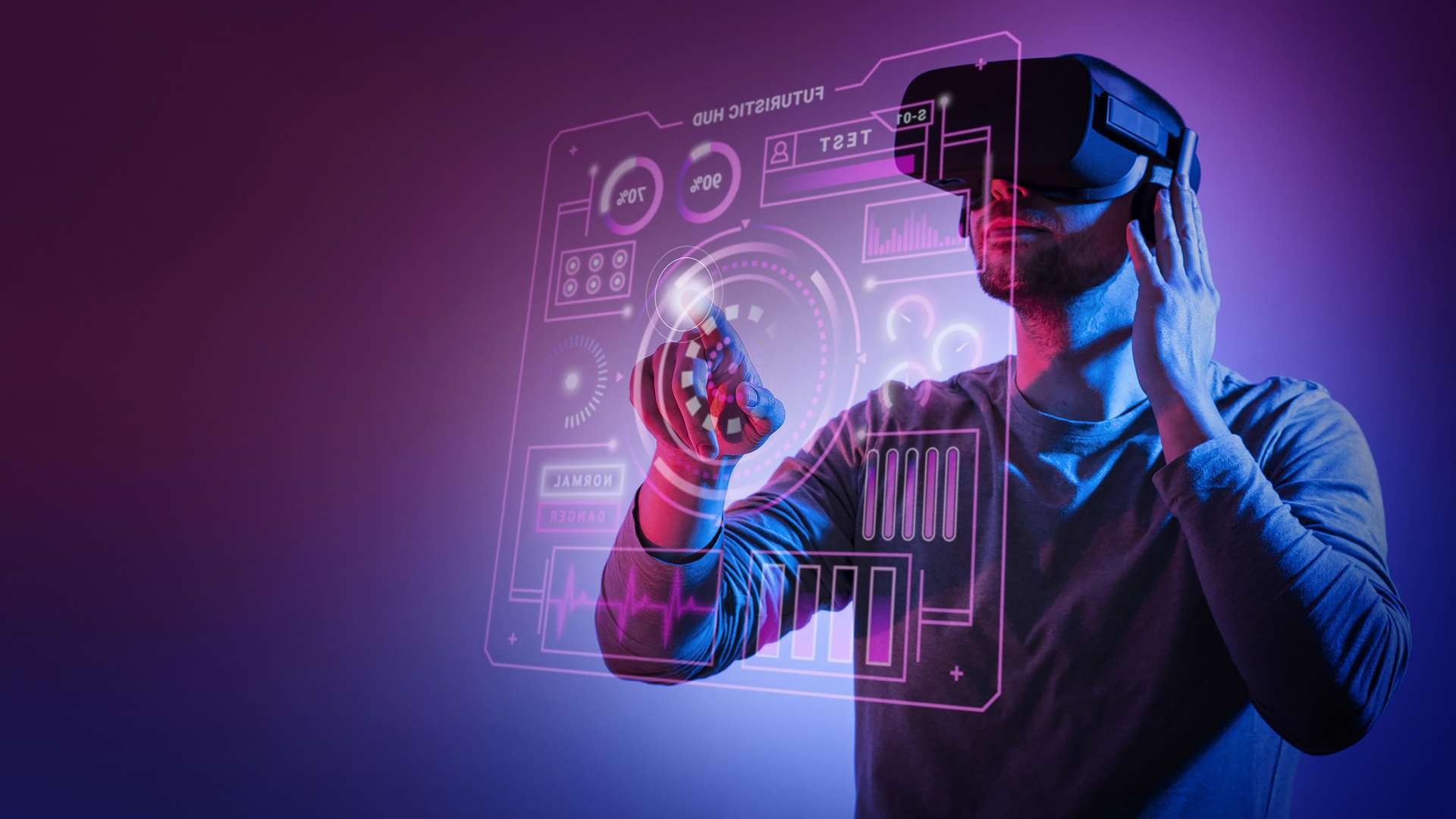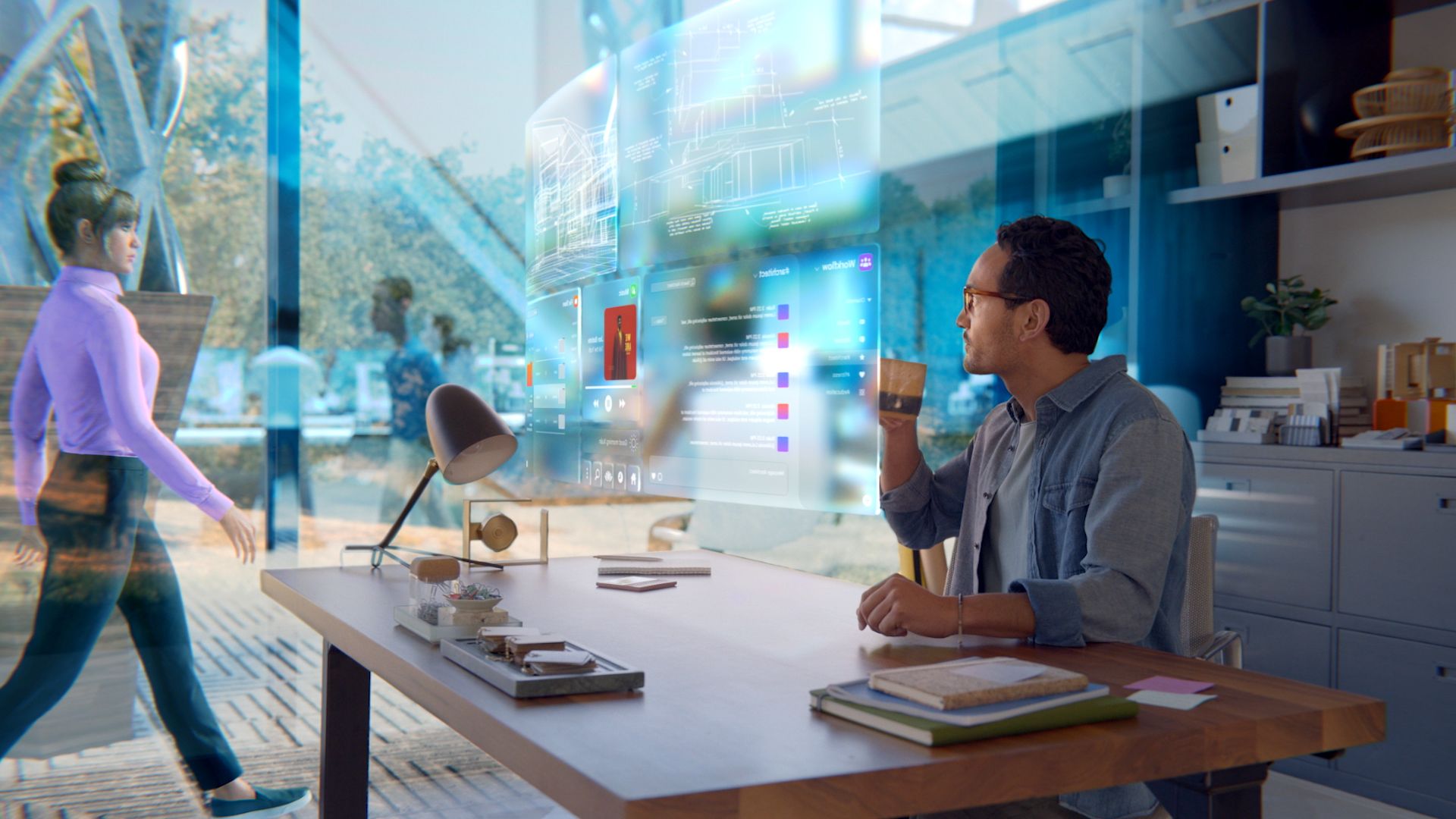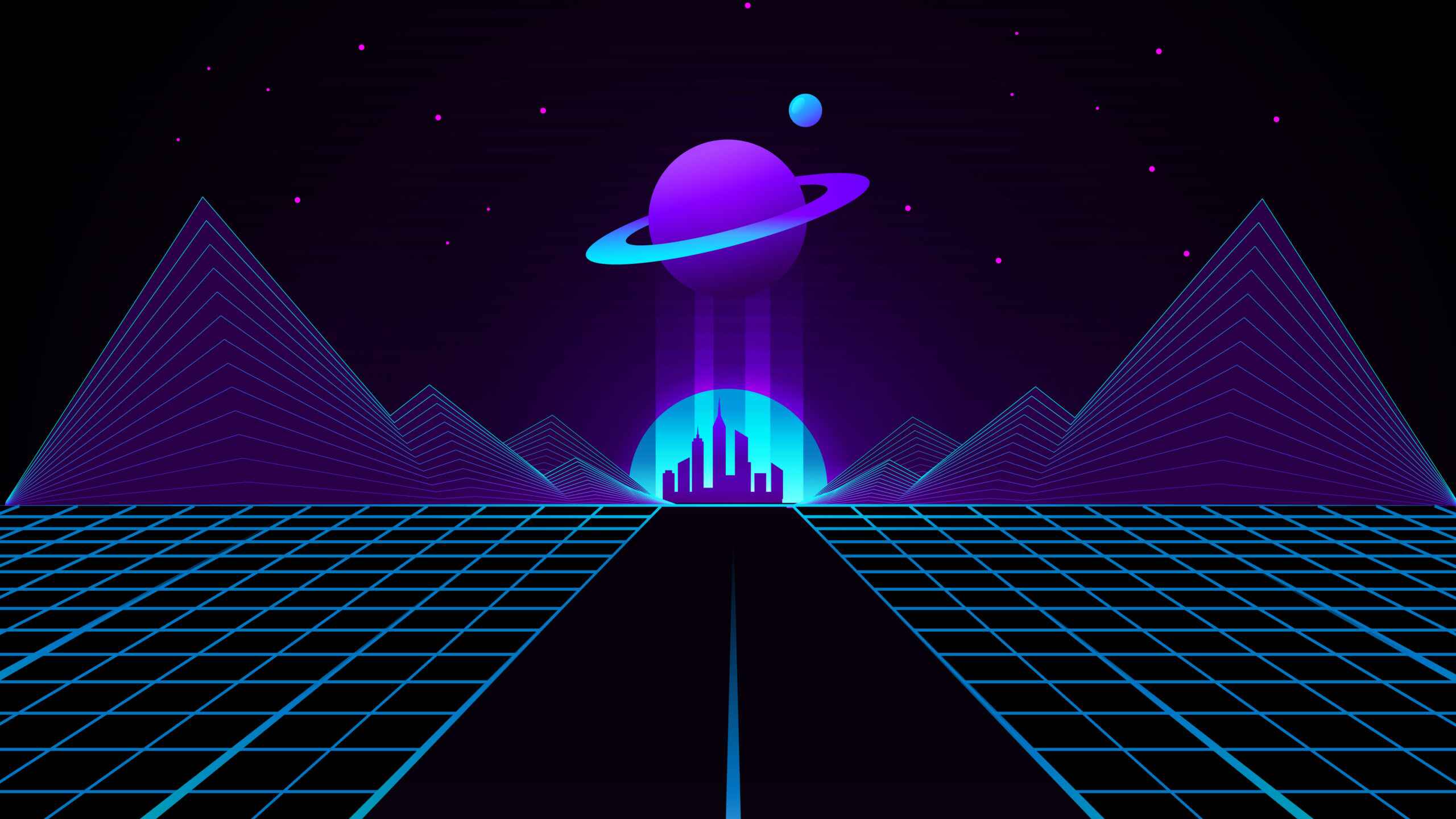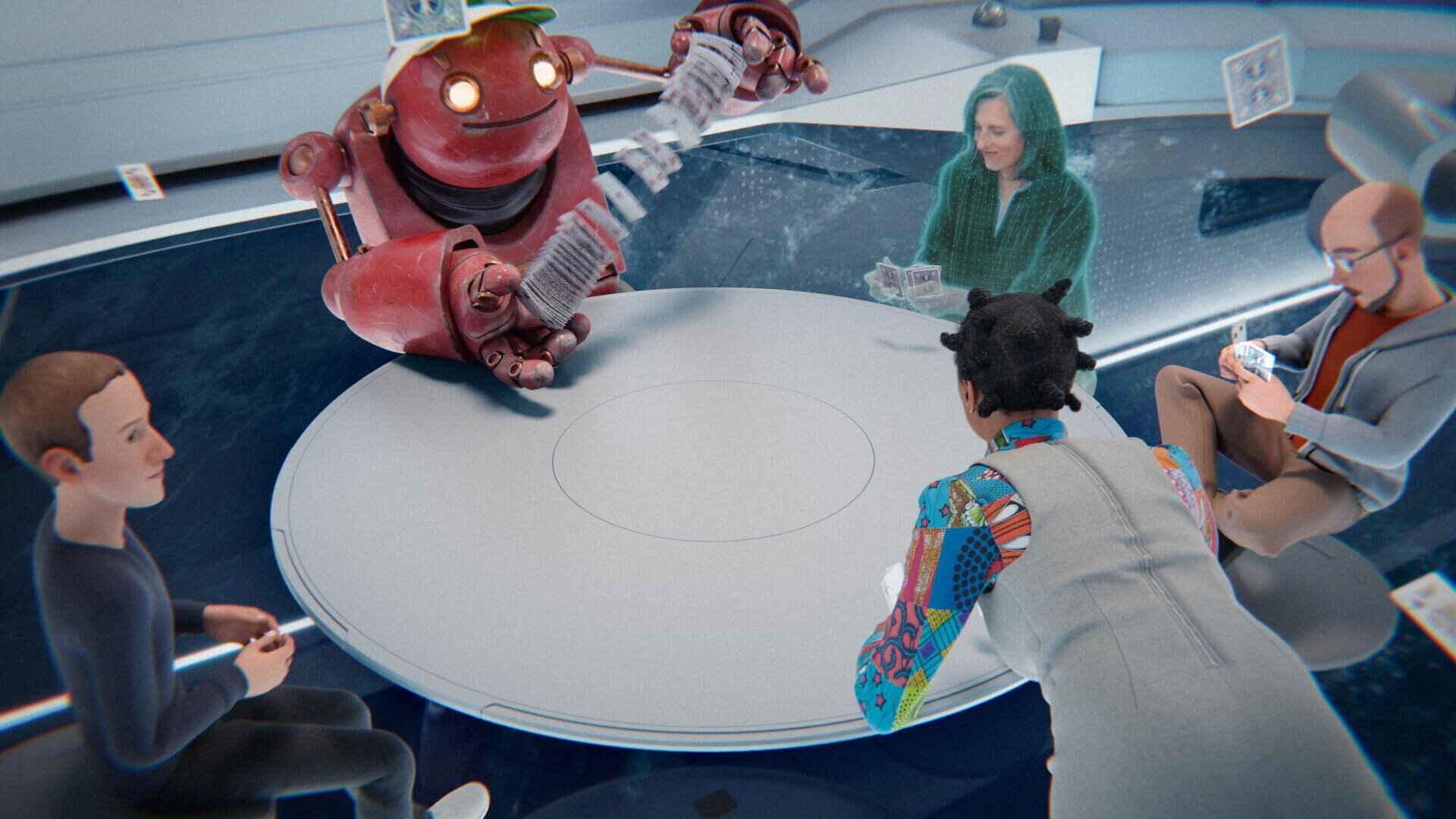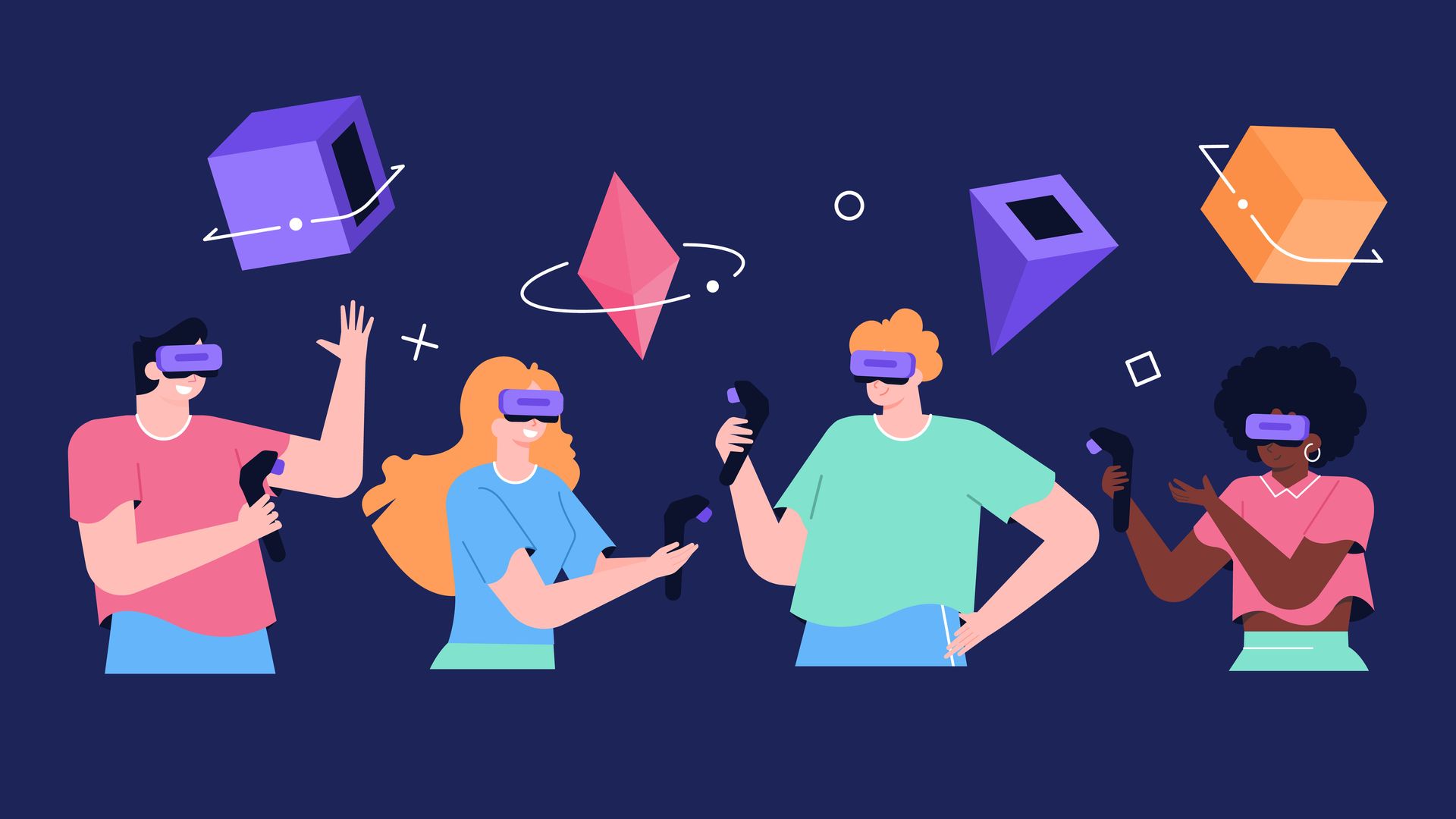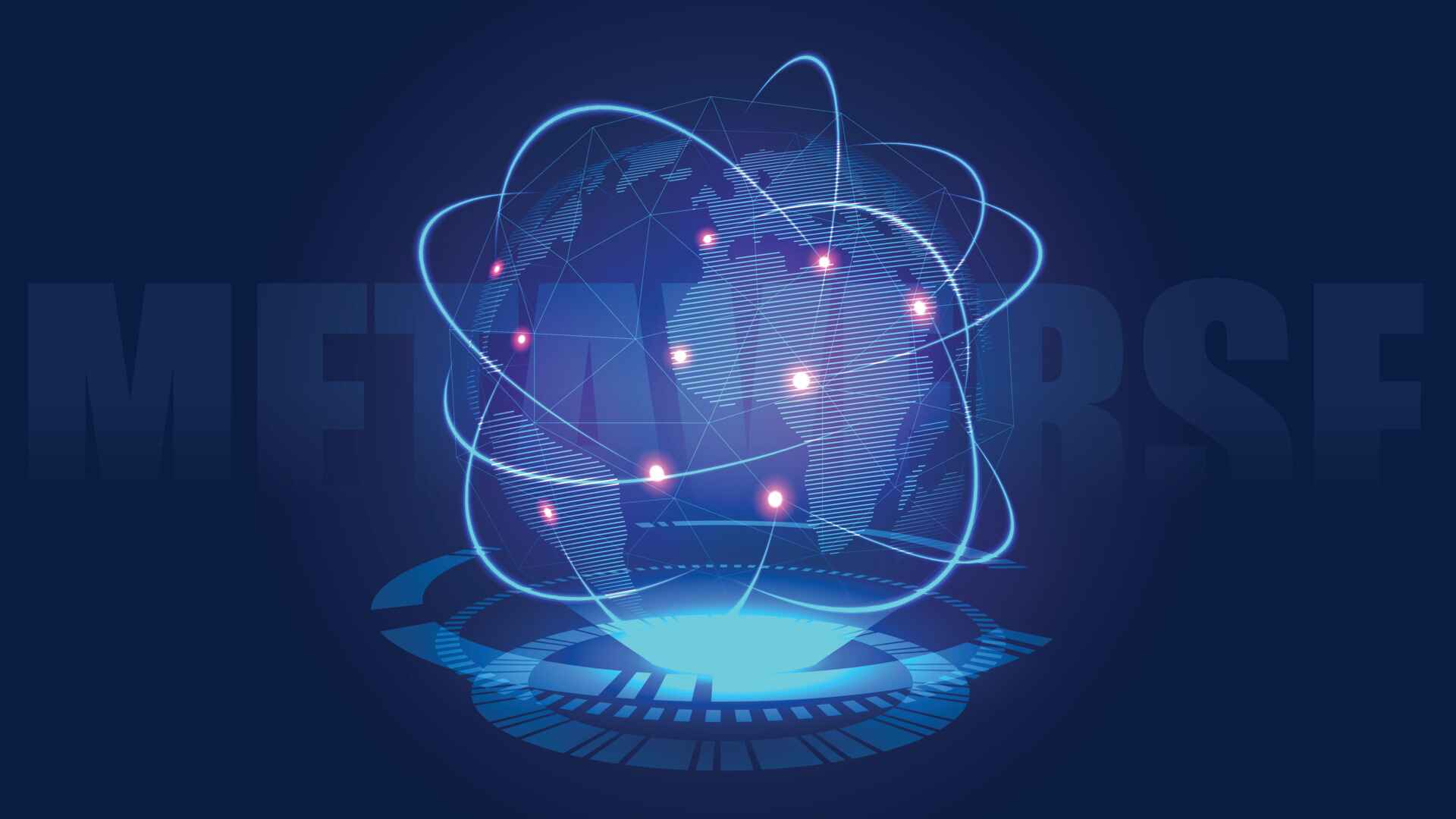Introduction
Welcome to the exciting world of the Metaverse! In recent years, the concept of the Metaverse has gained considerable attention, sparking both curiosity and enthusiasm among technology enthusiasts and developers alike. With technology advancing at an unprecedented pace, the Metaverse holds the promise of being a limitless virtual universe where people can interact, work, and play in entirely new ways. As the concept continues to evolve, the demand for skilled Metaverse developers is on the rise.
But what exactly is the Metaverse? At its core, the Metaverse is a virtual reality space that transcends the boundaries of the physical world. It allows individuals to immerse themselves in a digital realm where they can engage with others, explore virtual environments, and experience a wide range of interactive activities. From gaming and socializing to commerce and entertainment, the possibilities within the Metaverse are endless.
So, why should you consider becoming a Metaverse developer? The answer lies in the limitless opportunities that this emerging field presents. As a Metaverse developer, you have the chance to shape the future of virtual reality and create immersive experiences that captivate users from all corners of the globe.
To succeed as a Metaverse developer, you must possess a unique set of skills and knowledge. This includes programming proficiency, an understanding of blockchain technology, and the ability to design and build virtual worlds. In this article, we will explore the key steps and resources you need to embark on your journey to become a skilled Metaverse developer.
What is the Metaverse?
The term “Metaverse” refers to a digital realm that expands on the concept of virtual reality (VR) by creating an interconnected universe where people can interact with each other and the environment, blurring the lines between the physical and virtual worlds. In the Metaverse, users can engage in various activities, such as socializing, working, exploring, and gaming, all within a shared virtual space.
The Metaverse is not a single platform or application but rather a collective term for a vast network of interconnected virtual worlds and environments. It is an immersive and interactive space that offers users a sense of presence and agency, allowing them to navigate and manipulate their virtual surroundings.
One of the defining features of the Metaverse is its ability to support a multitude of experiences and interactions. Users can create their own avatars, which serve as their digital representations, and customize them to reflect their desired appearance. They can explore virtual landscapes, engage in social interactions with other users, trade virtual goods and assets, and participate in various forms of entertainment, including games and virtual events.
The Metaverse has the potential to revolutionize how we live, work, and interact with technology. Imagine attending a business meeting in a virtual boardroom, collaborating with colleagues from around the world, or experiencing a concert where musicians perform on a virtual stage. The possibilities are vast.
It’s important to note that the development of the Metaverse is an ongoing process, and there is no definitive version of it at present. Companies and developers are continuously working on creating platforms, technologies, and standards that will shape the future of the Metaverse.
As the Metaverse continues to evolve, it offers immense opportunities for developers to create novel and engaging experiences for users. The ability to blend creativity, technology, and user interaction makes the world of Metaverse development an exciting and rapidly growing field.
Why become a Metaverse Developer?
The rise of the Metaverse has opened up a world of possibilities for developers, making it an enticing field to explore. Here are some compelling reasons why you should consider becoming a Metaverse developer:
- Limitless Creativity: As a Metaverse developer, you have the opportunity to unleash your creativity and imagination. You can design and build immersive virtual worlds, create interactive experiences, and bring your ideas to life in ways that were once only limited to the realms of science fiction.
- Future-Proof Career: With major companies and tech giants investing heavily in the development of the Metaverse, it is evident that this field is set to grow exponentially. By investing your skills in Metaverse development, you position yourself for long-term career growth and job security in a rapidly expanding industry.
- Collaborative Environment: The Metaverse is not just about individual development, but also about collaboration and community building. As a Metaverse developer, you have the chance to work with like-minded individuals, share ideas, and collaborate on innovative projects that push the boundaries of what is possible.
- Impactful Experiences: The Metaverse has the power to impact various aspects of people’s lives. Whether it’s creating educational simulations, therapeutic applications, or social platforms that connect individuals across the globe, as a developer, you have the ability to shape experiences that can make a positive difference in people’s lives.
- Embrace New Technologies: Metaverse development is at the forefront of cutting-edge technologies such as virtual reality, augmented reality, blockchain, and artificial intelligence. By becoming a Metaverse developer, you get to stay ahead of the curve and explore the exciting possibilities these technologies offer.
By embarking on a career as a Metaverse developer, you become part of a rapidly evolving industry that is shaping the future of how we live, work, and connect with each other. The potential for innovation, creativity, and impact in the Metaverse is vast, making it an appealing career choice for tech enthusiasts and visionaries alike.
Skills and Knowledge Required
Being a Metaverse developer requires a unique set of skills and knowledge that combine elements of programming, design, and an understanding of emerging technologies. Here are some essential skills and knowledge areas to focus on:
- Programming Proficiency: A strong foundation in programming is vital for Metaverse development. Familiarize yourself with programming languages such as C#, Python, JavaScript, or UnityScript, which are commonly used in virtual reality (VR) and augmented reality (AR) development. Understanding object-oriented programming concepts and practices is crucial.
- Understanding of Blockchain Technology: The Metaverse often incorporates blockchain technology for secure transactions, ownership of digital assets, and decentralized governance. Familiarize yourself with the fundamentals of blockchain, including smart contracts and decentralized applications (DApps).
- Design and Visual Skills: Metaverse development requires a keen eye for design and aesthetics. Learn principles of user experience (UX) and user interface (UI) design to create intuitive and visually appealing virtual environments and interfaces.
- Knowledge of Virtual Reality (VR) and Augmented Reality (AR): Gain a solid understanding of the concepts, tools, and frameworks used in VR and AR development. Familiarize yourself with platforms such as Unity 3D, Unreal Engine, or WebAR technologies.
- Understanding of 3D Modeling and Animation: Metaverse development often involves building and animating 3D models. Familiarize yourself with software like Blender or Maya to create and manipulate 3D assets.
- Problem-Solving and Troubleshooting: Metaverse development involves working through complex technical challenges and debugging issues. Develop strong problem-solving skills and the ability to troubleshoot and debug code effectively.
- Continuous Learning and Adaptability: The Metaverse is a rapidly evolving field, so it’s important to stay updated with the latest trends, technologies, and tools. Embrace a continuous learning mindset and adapt to new opportunities and challenges.
While the above skills and knowledge areas are essential, remember that Metaverse development is a multidisciplinary field. It requires creativity, collaboration, and a willingness to explore new technologies and possibilities. By developing a well-rounded skill set and staying curious, you can position yourself as a proficient and sought-after Metaverse developer.
Learning Path for Metaverse Development
If you’re eager to embark on a journey to become a Metaverse developer, following a well-defined learning path can help you gain the necessary skills and knowledge. Here’s a suggested roadmap:
- Start with the Basics: Begin by learning the fundamentals of programming and computer science concepts. Familiarize yourself with languages like C# or Python, as they are commonly used in Metaverse development.
- Explore Virtual Reality (VR) and Augmented Reality (AR): Dive into the world of VR and AR development by learning platforms like Unity 3D or Unreal Engine. Understand the concepts of spatial computing and interaction design in virtual environments.
- Get Hands-On Experience: Practice your skills by undertaking small-scale Metaverse development projects. Build simple virtual environments, experiment with 3D modeling and animation tools, and implement basic interactivity.
- Deep Dive into Blockchain: Gain a deep understanding of blockchain technology and its applications in the Metaverse. Learn about concepts like smart contracts, decentralized finance (DeFi), and non-fungible tokens (NFTs).
- Expand Your Design Skills: Enhance your design skills by learning about user experience (UX) and user interface (UI) principles. Explore tools like Adobe XD or Figma to create visually appealing and user-friendly interfaces.
- Experiment with Emerging Technologies: Stay up-to-date with the latest trends and emerging technologies in the Metaverse. Experiment with tools and frameworks like WebAR, haptic technology, or spatial audio to add new dimensions to your projects.
- Join the Metaverse Developer Community: Engage with other developers and enthusiasts in the Metaverse developer community. Attend meetups, conferences, and online forums to network, learn from others, and collaborate on projects.
- Continuously Learn and Adapt: As the Metaverse evolves, keep expanding your skill set and staying in tune with technological advancements. Embrace a mindset of continuous learning to stay ahead in this rapidly changing field.
While this learning path provides a general roadmap, feel free to tailor it to your specific interests and goals. Remember to practice regularly, work on projects that showcase your skills, and always seek opportunities for growth and improvement. The journey to becoming a skilled Metaverse developer is exciting and constantly evolving, so enjoy the process and embrace the endless creative possibilities it offers.
Understanding Blockchain Technology
In the world of Metaverse development, blockchain technology plays a crucial role in enabling secure transactions, ownership verification of digital assets, and decentralized governance. Understanding the basics of blockchain is essential for Metaverse developers. Here’s a breakdown of key concepts:
Decentralization: Unlike traditional centralized systems, blockchain operates on a decentralized model. It is a distributed ledger that is maintained by a network of computers (nodes) rather than a central authority. This enables transparency, immutability, and security.
Blocks and Chain: A blockchain consists of blocks, which are containers that store verified transactions or data. Each block contains a unique identifier (hash) and a reference to the previous block, creating a chain-like structure.
Cryptographic Security: Blockchain employs cryptographic algorithms to secure data. Transactions are encrypted and linked together, making it virtually impossible to alter past records without consensus from the network.
Smart Contracts: Smart contracts are self-executing contracts with predefined rules written as code. They automatically execute transactions when certain conditions are met, eliminating the need for intermediaries.
Consensus Mechanisms: Consensus mechanisms ensure agreement among nodes in a blockchain network. Popular mechanisms include Proof of Work (PoW) and Proof of Stake (PoS), where nodes compete or stake their resources to validate transactions and earn rewards.
Tokenization: Blockchain enables the creation of digital assets or tokens. These tokens can represent anything from cryptocurrencies to digital collectibles or virtual land within the Metaverse, providing a way to authenticate ownership and facilitate trade.
As a Metaverse developer, understanding blockchain technology opens up opportunities for implementing secure transactions, creating decentralized applications, and enabling personal ownership and control of digital assets within virtual environments.
There are various resources available to deepen your understanding of blockchain. Explore online courses, articles, and tutorials to learn about blockchain frameworks like Ethereum or tools like Solidity for writing smart contracts. Stay updated with the latest developments in blockchain technology, as advancements can greatly impact the Metaverse ecosystem.
By grasping the fundamentals of blockchain technology, you equip yourself with the knowledge to leverage its power within the Metaverse, paving the way for innovative and secure experiences for users.
Programming Languages for Metaverse Development
Programming languages play a crucial role in Metaverse development, enabling developers to create immersive virtual experiences and interactive features. Here are some programming languages commonly used in Metaverse development:
C#: C# is a powerful and versatile language widely used in game development, making it a popular choice for virtual reality (VR) and augmented reality (AR) applications. It is the primary programming language used in the Unity game engine, which is widely utilized for building Metaverse experiences.
Python: Python is a versatile language with a user-friendly syntax, making it an excellent choice for Metaverse development. Python is commonly used for scripting and automation tasks in VR and AR projects, including tasks related to data manipulation, AI integration, and backend development.
JavaScript: JavaScript is a versatile language that works well in web-based Metaverse development. It is commonly used for creating interactive and dynamic elements within virtual environments, such as user interfaces, animations, and event handling.
UnityScript: UnityScript, also known as Unity’s JavaScript, is a variant of JavaScript that is specifically designed for use with the Unity game engine. It offers a familiar syntax for JavaScript programmers and is commonly used for scripting game logic and creating interactive elements in Metaverse experiences built with Unity.
C++: C++ is a powerful and efficient language commonly used in game engines and performance-critical applications. While it may not be the most beginner-friendly choice, it offers optimal performance and gives developers fine-grained control over their Metaverse projects.
These are just a few examples of programming languages used in Metaverse development. The choice of language depends on the specific requirements of the project and the platforms or engines being utilized. It’s important to choose a language that aligns with your goals and expertise.
To get started with a programming language, explore online tutorials, documentation, and interactive coding platforms. Practice coding through small-scale projects and gradually work your way up to more complex Metaverse development tasks. Join online communities and forums where you can connect with fellow developers and seek guidance.
Remember that mastering a programming language is an ongoing process. Stay updated with the latest frameworks, libraries, and best practices within the Metaverse development ecosystem to ensure that you’re utilizing the most efficient and effective techniques in your projects.
Building Virtual Worlds and Environments
As a Metaverse developer, one of your primary responsibilities is to create virtual worlds and environments that immerse users in unique and captivating experiences. Building these virtual spaces involves various elements such as design, 3D modeling, and interactivity. Here are key considerations for building virtual worlds and environments:
Conceptualization and Design: Begin by conceptualizing the vision and theme of your virtual world. Consider factors such as the target audience, intended user interactions, and overall atmosphere. Sketch out the layout, architecture, and aesthetics to guide your design process.
3D Modeling and Asset Creation: Utilize software like Blender, Maya, or Unity’s ProBuilder to create 3D models of objects, buildings, landscapes, and characters within your virtual world. Properly optimize the models for real-time rendering in the Metaverse environment.
Texturing and Materials: Apply textures and materials to your 3D models to bring them to life. Consider the lighting conditions and the desired aesthetic style of your virtual world. Experiment with shaders and materials to achieve the desired visual effects.
Optimization and Performance: Ensure that your virtual world is optimized for optimal performance. Use level of detail (LOD) techniques, occlusion culling, and proper asset management to minimize rendering load and provide a smooth user experience, especially in resource-intensive environments.
Physics and Interactivity: Implement physics simulations and interactive elements to enhance the immersive experience. Use physics engines, such as Unity’s PhysX, to simulate realistic object behavior and allow users to interact with the virtual world through gestures, movements, or object manipulation.
Navigation and Pathfinding: Design efficient paths and navigation systems that guide users through the virtual environment. Implement pathfinding algorithms to allow virtual characters or NPCs to navigate the world intelligently.
Sound and Music: Utilize audio elements to enhance the immersive experience. Implement spatial audio techniques to create realistic soundscapes that match the user’s position and movement within the virtual world. Consider using ambient sounds, music, or character dialogues to add depth to the environment.
User Testing and Iteration: Conduct user testing to gather feedback and insights on the usability and enjoyment of your virtual world. Iterate and refine your design based on user observations, ensuring that the experience is engaging, intuitive, and optimized for different devices and platforms.
Building virtual worlds and environments in the Metaverse requires a combination of artistic and technical skills. Practice regularly, learn from existing virtual worlds, and stay updated with new tools and techniques in the field. By mastering the art of creating captivating virtual spaces, you can provide users with immersive and unforgettable experiences within the Metaverse.
Creating Avatars and Characters
Avatars and characters are essential components of the Metaverse, as they serve as digital representations of users and play a vital role in facilitating interactions and personalization within virtual worlds. As a Metaverse developer, creating compelling avatars and characters requires careful consideration of design, customization, and functionality. Here are key factors to consider:
Design and Appearance: Begin by conceptualizing the visual design of your avatars and characters. Determine the art style, proportions, and overall aesthetic that align with the world and theme of your virtual environment. Pay attention to details such as facial features, body types, and attire to create diverse and visually appealing characters.
Customization Options: Provide users with a range of customization options for their avatars and characters. Incorporate features such as hairstyles, clothing options, accessories, and customizable facial features to allow users to express their uniqueness and personal style.
Animation and Rigging: Animate your avatars and characters to bring them to life. Implement rigging techniques to enable realistic movement and flexibility. Consider facial animation to convey emotions and body animation for lifelike gestures and expressions.
Expressions and Emotions: Implement a wide range of expressions and emotions for your avatars and characters. Consider using blendshape systems or facial animation rigs to allow users to express themselves and communicate non-verbally within the virtual world.
Interaction and Gestures: Enable interaction and gestures for avatars and characters to enhance user engagement. Implement systems for waving, dancing, sitting, or other user-triggered animations that promote social interactions within the Metaverse.
Accessibility and Inclusivity: Design avatars and characters with inclusivity in mind, ensuring that users of all genders, ethnicities, and abilities feel represented. Provide options for body diversity, inclusive clothing options, and customizable features that accommodate various personal preferences.
Performance and Optimization: Optimize avatars and characters for efficient real-time rendering. Utilize techniques such as LOD (level of detail) models, skeletal optimizations, and texture atlasing to minimize performance impact while maintaining visual quality.
Integration with Social Features: Integrate avatars and characters with social features to enable seamless communication and interactions between users. Implement systems for gesture recognition, voice chat, or text-based communication to enhance social engagement within the Metaverse.
As a Metaverse developer, creating avatars and characters that are visually appealing, customizable, and expressive enhances the user’s sense of presence and personal connection within the virtual world. Continuously iterate and improve your avatar and character design based on user feedback to offer a diverse, inclusive, and engaging experience for all users of the Metaverse.
Designing Interactive Experiences
When it comes to the Metaverse, interactivity is a fundamental element that keeps users engaged and immersed in virtual environments. As a Metaverse developer, designing interactive experiences is essential to provide meaningful and captivating interactions. Here are key considerations to keep in mind:
User-Centered Design: Begin by understanding the needs, preferences, and behaviors of your target audience. Design interactive experiences that cater to these user requirements, ensuring that interactions feel natural, intuitive, and enjoyable.
Clear Objectives and Goals: Define clear objectives for your interactive experiences. Determine the purpose of the interaction, whether it’s for entertainment, education, exploration, or collaboration. Align the objectives with the overall theme or narrative of the virtual environment.
Engaging User Interface (UI): Create a visually appealing and user-friendly UI for your interactive experiences. Ensure that the UI elements are intuitive, easy to navigate, and provide clear feedback to users. Incorporate interactive elements, such as buttons, sliders, or gesture-based controls, for seamless user interaction.
Multimodal Interactions: Design interactive experiences that leverage a combination of sensory inputs, such as voice commands, hand gestures, or body movements. By incorporating multimodal interactions, you can enhance the immersion and provide a more natural and intuitive user experience.
Gameplay Mechanics: Incorporate gameplay mechanics that offer challenges, rewards, and incentives to users. Introduce puzzles, quests, leaderboards, or achievements to motivate users to explore and engage with the virtual world. Strive for a balanced and enjoyable gameplay experience.
Social Interactions: Create opportunities for social interactions within your interactive experiences. Implement features such as chat systems, virtual gatherings, or collaborative activities that foster connections and allow users to interact with each other in meaningful ways.
Storytelling and Immersion: Use narrative elements and storytelling techniques to engage users and immerse them in the virtual environment. Design interactive experiences that unfold a compelling storyline, offering users a sense of purpose and progression as they navigate through the Metaverse.
Feedback and Responsiveness: Ensure that interactive elements provide immediate and meaningful feedback to users. Incorporate audiovisual cues, haptic feedback, or animation to acknowledge user actions and provide a sense of responsiveness and interactivity.
Iterative Design and Testing: Continuously iterate and refine your interactive experiences based on user feedback and testing. Conduct usability testing to identify pain points, optimize the user flow, and improve the overall user experience.
By keeping these design considerations in mind, you can create interactive experiences within the Metaverse that captivate users, promote exploration, and foster social connections. Strive to provide an immersive and engaging environment that keeps users coming back for more, making the Metaverse a truly interactive and dynamic digital realm.
Implementing Blockchain Integration
Integrating blockchain technology into the Metaverse can bring numerous benefits, such as enabling secure transactions, facilitating ownership verification of digital assets, and providing decentralized governance. As a Metaverse developer, understanding how to implement blockchain integration is essential. Here are key considerations:
Selecting the Right Blockchain: Determine the blockchain platform that aligns with your project’s requirements. Consider factors such as scalability, transaction speed, community support, and smart contract functionality. Popular blockchain platforms for Metaverse development include Ethereum, Binance Smart Chain, and Polygon.
Smart Contracts Development: Utilize programming languages like Solidity or Vyper to develop smart contracts that govern the rules and logic of your Metaverse application. Create smart contracts to handle transactions, manage digital assets, and establish ownership mechanisms within the virtual environment.
Tokenization of Digital Assets: Tokenize digital assets like virtual land, characters, or in-game items using blockchain standards such as ERC-721 (Non-Fungible Token) or ERC-20 (Fungible Token). This allows for verifiable ownership, secure peer-to-peer trading, and the creation of vibrant digital economies within the Metaverse.
Decentralized Identity and Authentication: Leverage decentralized identity solutions to enable secure and verifiable user authentication within the Metaverse. Implement identity protocols like Decentralized Identifiers (DIDs) or Self-Sovereign Identity (SSI) systems to ensure privacy, user control, and seamless interoperability across different platforms and Metaverse experiences.
Blockchain-Backed Economies: Explore the integration of decentralized finance (DeFi) concepts within your Metaverse project. Create mechanisms for earning, staking, or lending digital assets, allowing users to participate in a vibrant and autonomous economic ecosystem.
Cross-Chain Interoperability: Investigate solutions that enable interoperability between different blockchain networks. This allows users to move seamlessly between multiple virtual worlds and Metaverse experiences while retaining their digital assets and identities.
Marketplace Integration: Integrate decentralized marketplaces within the Metaverse to facilitate the buying, selling, and trading of digital assets. Implement protocols like OpenSea or Rarible to provide users with a seamless and secure platform for exchanging virtual goods and collectibles.
Community Governance: Leverage blockchain’s decentralized governance mechanisms, such as DAOs (Decentralized Autonomous Organizations), to involve the community in decision-making processes within the Metaverse. Enable token holders to participate in voting, proposal submission, and fund allocation, fostering a sense of ownership and community involvement.
By implementing blockchain integration in the Metaverse, you empower users with secure ownership, interoperability, and vibrant economic opportunities. Stay updated with advancements in blockchain technology, explore available tools and frameworks, and consider the specific needs of your Metaverse project to leverage blockchain’s transformative potential within the virtual world.
Testing and Debugging Metaverse Applications
Testing and debugging are essential aspects of Metaverse development to ensure the stability, functionality, and user experience of your applications within virtual environments. Here are key considerations for effectively testing and debugging Metaverse applications:
Test Environment Setup: Create a dedicated test environment that closely resembles the production environment of your Metaverse application. This helps simulate real-world conditions and accurately identify potential issues early on.
Unit Testing: Conduct unit tests to verify the correctness of individual components, such as smart contracts, scripts, or modules, within your Metaverse application. Use testing frameworks and libraries specific to your chosen programming language or platform.
Integration Testing: Perform integration tests to ensure the seamless operation of different modules, systems, or APIs within your Metaverse application. Validate the interaction and compatibility between different components to detect any functional or communication issues.
Performance Testing: Test the performance and scalability of your Metaverse application under various loads and scenarios. Assess factors such as response time, resource consumption, network latency, and user experience to optimize performance and enhance the overall user satisfaction.
User Experience Testing: Prioritize the testing of user interactions and experiences to ensure intuitive navigation, smooth animations, and immersive gameplay within the Metaverse. Pay attention to factors such as easy controls, responsive feedback, and overall enjoyment.
Security Testing: Conduct security audits and penetration testing to identify potential vulnerabilities within your Metaverse application. Assess the security of smart contracts, authentication mechanisms, and data encryption implementations to safeguard user assets and privacy.
Debugging Tools and Logs: Utilize debugging tools provided by development environments or specialized debugging tools for Metaverse platforms. Analyze logs, error messages, and stack traces to pinpoint and resolve issues efficiently.
User Feedback and Beta Testing: Involve users and stakeholders in the testing process through beta testing or user feedback sessions. Gather insights, address usability issues, and incorporate valuable suggestions to improve the overall user experience and functionality.
Continuous Integration and Deployment: Implement automated testing and continuous integration processes to streamline the testing and debugging workflows. This ensures that subsequent code changes or feature updates undergo thorough testing before deployment.
Regression Testing: Perform regression testing after making updates or introducing new features to your Metaverse application. This ensures that existing functionality remains intact and that new changes do not introduce unintended issues.
By implementing comprehensive testing and debugging practices within your Metaverse application, you can ensure its stability, optimize performance, and deliver a seamless user experience within the virtual world. Embrace a proactive and iterative approach to testing and debugging, working closely with users and feedback to continuously improve the quality and reliability of your Metaverse applications.
Collaborating and Networking in the Metaverse Developer Community
Collaboration and networking within the Metaverse developer community are crucial for growth, knowledge sharing, and staying up-to-date with the latest trends and technologies. Building relationships and actively participating in the community can bring numerous benefits. Here are key considerations for effective collaboration and networking:
Join Online Forums and Communities: Engage with the Metaverse developer community through online forums, social media groups, and dedicated platforms. Participate in discussions, ask questions, and share your insights. This allows you to connect with like-minded individuals, gain valuable knowledge, and establish your presence within the community.
Attend Meetups and Conferences: Attend virtual or in-person meetups, conferences, and events focused on Metaverse development. These gatherings offer opportunities to network with other professionals, learn from industry experts, and discover new technologies and project collaborations.
Contribute to Open Source Projects: Contribute to open source projects related to Metaverse development. Collaborating on open source initiatives not only improves your skills but also enables you to work alongside experienced developers and have a positive impact on the ecosystem as a whole.
Share your Knowledge and Expertise: Write blog posts, create video tutorials, or speak at conferences to share your insights and experiences in Metaverse development. Contributing your knowledge to the community helps others and establishes you as a trusted and respected authority in the field.
Join Hackathons and Game Jams: Participate in Metaverse-focused hackathons and game jams to collaborate with others on creative projects within a limited timeframe. These events foster teamwork, innovation, and the opportunity to showcase your skills to potential collaborators or employers.
Network on Virtual Social Platforms: Explore virtual social platforms within the Metaverse itself and engage with other developers, enthusiasts, and potential collaborators. Virtual worlds provide unique opportunities for networking, building relationships, and experiencing the Metaverse firsthand.
Collaborate on Metaverse Projects: Look for opportunities to collaborate with other developers on Metaverse projects. Collaborative projects allow for skill-sharing, knowledge exchange, and the creation of more impactful and ambitious experiences within the Metaverse.
Mentorship and Mentorship Programs: Seek mentorship from experienced developers or consider becoming a mentor yourself. Mentorship programs foster personal growth, provide guidance, and help create a supportive and inclusive community.
Stay Up-to-Date: Continuously educate yourself on the latest developments in Metaverse development. Follow industry news, read technical blogs, and explore emerging technologies related to the Metaverse. Staying informed keeps you ahead of the curve and facilitates meaningful contributions within the community.
By actively collaborating and networking within the Metaverse developer community, you can accelerate your growth, gain valuable insights, forge meaningful connections, and contribute to the advancement of the Metaverse ecosystem as a whole.
Conclusion
The Metaverse represents a transformative and dynamic digital realm that is reshaping how we interact, work, and play. As a Metaverse developer, you have a unique opportunity to shape this immersive virtual universe and create experiences that captivate users from all over the world.
Throughout this article, we explored various aspects of becoming a skilled Metaverse developer. From understanding the concept of the Metaverse to acquiring the necessary skills and knowledge, we delved into the world of blockchain integration, virtual world design, avatar creation, interactive experiences, and collaborating within the Metaverse development community.
To succeed as a Metaverse developer, it is essential to continuously update your skills, stay informed about the latest technologies, and embrace a mindset of lifelong learning. Additionally, building relationships and networking within the Metaverse developer community can lead to valuable collaborations and growth opportunities.
The Metaverse is a rapidly evolving field, and the possibilities within it are endless. By honing your programming skills, harnessing the power of blockchain, and leveraging your creativity, you can contribute to the creation of immersive environments, engaging experiences, and interconnected virtual worlds that redefine how we live and interact.
Embrace the challenges and opportunities that lie ahead as you embark on your journey to become a skilled Metaverse developer. Stay curious, persistent, and open to new ideas, and let your passion for technology and innovation guide you as you shape the future of the Metaverse.







